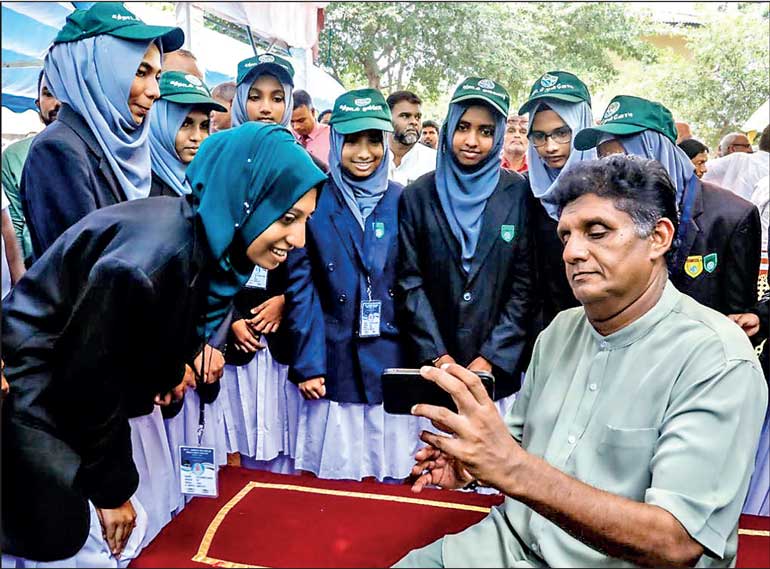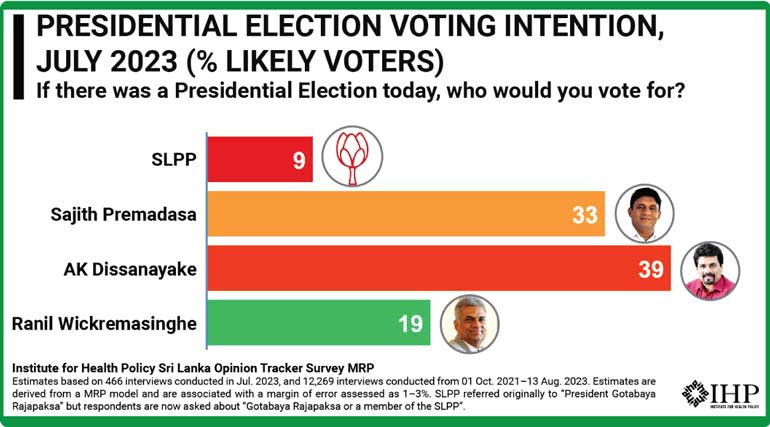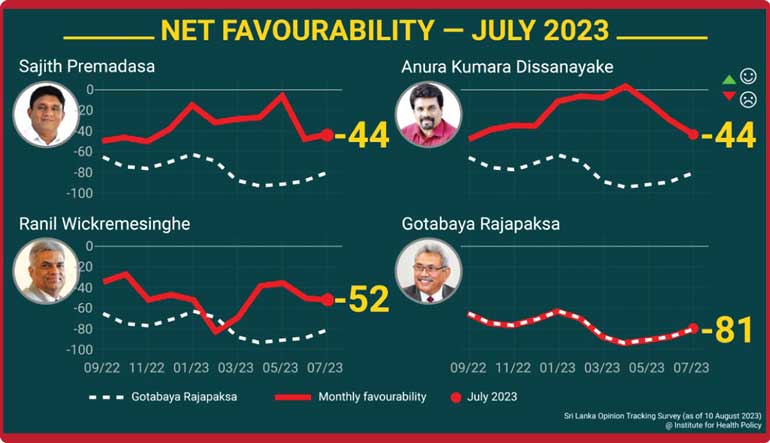Friday Dec 05, 2025
Friday Dec 05, 2025
Thursday, 24 August 2023 00:40 - - {{hitsCtrl.values.hits}}

Can Sajith convince the uncommitted?

Ranil running third

SJB ahead by a whisker
 New public opinion polls out from International Health Policy (IHP) SLOTS tracker, taken together, reveal 10 political trends. Here’s the most dramatic takeaway from Dr. Rannan-Eliya, IHP Executive Director:
New public opinion polls out from International Health Policy (IHP) SLOTS tracker, taken together, reveal 10 political trends. Here’s the most dramatic takeaway from Dr. Rannan-Eliya, IHP Executive Director:
“These latest results again confirm that a large share of the electorate is increasingly uncertain who to support. This would suggest that none of the major parties have succeeded in making a convincing case to the public, and it implies that there is potential for big changes in support in coming months.”
30% of voters are uncommitted.
Ranil’s game-plan
Ranil’s political strategy is as transparent as it is unrealistic:
 The Mangala Samaraweera method, as set out by him in a piece in our Sunday sister-paper in late 2014, before the presidential election of early 2015--win a massive majority of the minorities so as to require only a minority of the majority to win.
The Mangala Samaraweera method, as set out by him in a piece in our Sunday sister-paper in late 2014, before the presidential election of early 2015--win a massive majority of the minorities so as to require only a minority of the majority to win.
 Retrieve a sizeable segment of SJB MPs and voters. The upcoming reform of the UNP constitution will supposedly accommodate dual membership by the SJB, SLPP, and Patali’s URP.
Retrieve a sizeable segment of SJB MPs and voters. The upcoming reform of the UNP constitution will supposedly accommodate dual membership by the SJB, SLPP, and Patali’s URP.
 Split the SLPP, win over many MPs.
Split the SLPP, win over many MPs.
 Induct Champika to counter Sajith and Anura.
Induct Champika to counter Sajith and Anura.
 Pressurize Sajith to endorse Ranil as presidential candidate and accept PM-ship.
Pressurize Sajith to endorse Ranil as presidential candidate and accept PM-ship.
Like Gruyere cheese, Ranil’s strategy is full of holes.
 Mangala’s mathematics worked only for a short while before a tidal backlash wrecked both UNP and SLFP. Even in the short-term it succeeded because the candidate was SLFP Gen-Sec Maithripala Sirisena whose wartime political record and patriotic-populist credentials were impeccable.
Mangala’s mathematics worked only for a short while before a tidal backlash wrecked both UNP and SLFP. Even in the short-term it succeeded because the candidate was SLFP Gen-Sec Maithripala Sirisena whose wartime political record and patriotic-populist credentials were impeccable.
 The Ranil-Solheim-Milinda reunion, Ranil’s Indianization agenda and multiple MoUs, his drive to connect the North-East with Tamil Nadu while Tamil Nadu Chief Minister and DMK head-honcho Stalin demands Kachchatheevu back, his meeting in India with Subaskaran Alirajah, and his bid for 13A++, have revived memories of his CFA sellout and national nihilism.
The Ranil-Solheim-Milinda reunion, Ranil’s Indianization agenda and multiple MoUs, his drive to connect the North-East with Tamil Nadu while Tamil Nadu Chief Minister and DMK head-honcho Stalin demands Kachchatheevu back, his meeting in India with Subaskaran Alirajah, and his bid for 13A++, have revived memories of his CFA sellout and national nihilism.
 Ranil’s course will trigger a Sinhala voter backlash with the only question being whether Anura or Sajith will be the beneficiary. So far, Sajith has avoided Ranasinghe Premadasa’s election-winning patriotic pledge of 1988 (de-induction of Indian forces) and observed a scrupulous silence on Ranil’s supine Indophilia while Anura has been incrementally foregrounding the issue. It is likely therefore, that on present form, AKD will be the primary beneficiary of a nationalist/patriotic backlash.
Ranil’s course will trigger a Sinhala voter backlash with the only question being whether Anura or Sajith will be the beneficiary. So far, Sajith has avoided Ranasinghe Premadasa’s election-winning patriotic pledge of 1988 (de-induction of Indian forces) and observed a scrupulous silence on Ranil’s supine Indophilia while Anura has been incrementally foregrounding the issue. It is likely therefore, that on present form, AKD will be the primary beneficiary of a nationalist/patriotic backlash.
 Coalitions of Catholic laity have denounced Ranil’s crass conduct at Madhu, so he won’t get most of the Catholic vote unlike MS did in 2015.
Coalitions of Catholic laity have denounced Ranil’s crass conduct at Madhu, so he won’t get most of the Catholic vote unlike MS did in 2015.
 Any SJB and SLPP MPs who support Ranil will risk leaving their voters behind for their rivals to pick up. The evidence is the wreckage of the SLFP after Yahapalanaya. Neither UNP nor SLPP voters will give a preference vote to SLPP MPs who defect to Ranil.
Any SJB and SLPP MPs who support Ranil will risk leaving their voters behind for their rivals to pick up. The evidence is the wreckage of the SLFP after Yahapalanaya. Neither UNP nor SLPP voters will give a preference vote to SLPP MPs who defect to Ranil.
 SJB MPs who may defect to Ranil will learn that though their original vote-base was UNP, those voters have shifted due to economic agony and will vote for change.
SJB MPs who may defect to Ranil will learn that though their original vote-base was UNP, those voters have shifted due to economic agony and will vote for change.
Anura should rethink to win
AKD’s status as frontrunner shows he is doing something right, while his comparative shrinkage by 15% means he is doing something wrong.
“The correctness or incorrectness of the political line decides everything,” said Mao Zedong. Anura is pushing 5 main ideas which taken together constitute the ‘political line’ of the NPP-JVP:
(i) The crisis is the result of 75 years of wrong policies and bad governance.
(ii) The economic crisis is sourced in the open economy of 1977, i.e., 46 years ago, not 75-- before which national industries were built-up.
(iii) The present situation is one of division into two camps, which is inevitable and welcome. One camp will embrace the entire political establishment, comprising all those parties and factions which wielded power since 1948 and are responsible for the crisis. The other camp is represented by the NPP.
(iv) The NPP-JVP will not form any united front with any other political party.
(v) The 2024 Presidential election is inevitable as is the victory of the NPP-JVP camp.
To win, AKD and the NPP-JVP should consider the following:
I. Insisting that the crisis dates back 75 years and embraces the entire 75 years is palpably inaccurate. The people are in shock precisely because there has been a vertical drop; things are worse in some respects than they were in wartime. The evidence and the expert opinion of economists in the progressive camp, is that the contemporary crisis dates back to 2015 and brackets the Gotabaya and Ranil administrations.
II. The NPP-JVP’s periodization of the crisis as post-1948 flies in the face of the experience of millions who recall the primarily positive side of various administrations and leaders. This doesn’t mean the NPP-JVP should ally with the old establishment parties, but that its periodization helps create a large percentage (30%) that is with neither SJB nor NPP.
III. The NPP-JVP displays confusion as to whether the crisis dates back to 1948, which means 75 years, or to the Open Economy which means 45 years.
IV. Anura’s discourse which denounces the open economy of 1977 but praises the endogenous industrialisation of before, i.e., under Sirimavo and NM, raises the reasonable doubt that the NPP in office will return to the pre-1977 economy. His references to the Asian model—India, China, East Asia—don’t sit logically with his statist ‘economic nationalist’ nostalgia for the pre-1977 Sri Lankan economy.
V. The NPP-JVP’s conjoined ideas of the inexorable polarization into two camps and rejection of united fronts even under its own leadership, is fundamentally erroneous. Nationally and internationally, socioeconomic polarization most often doesn’t manifest itself neatly as political polarisation into two camps.
VI. In 1988, the most intense crisis faced by the state was expected by the JVP to cause a class polarization into two camps. Ranasinghe Premadasa’s candidacy was perceived/presented by the JVP as merely a new mask for the Jayewardene UNP regime. In truth there was much more discontinuity than continuity-- and the people felt it in their bones. While the JVP-NPP could be right about a ‘class compact’ this time, it could just as well be making the same mistake as in 1988 by betting on an inevitable Sajith-Ranil convergence. The JVP-NPP’s two-camp theory and politico-electoral strategy would collapse IF – but only if --Sajith were to run aggressively against Ranil and do so on a Ranasinghe Premadasa developmental-populist/social democratic platform.
VII. Even when there is polarisation into two camps, the left prevails only if there is a broad united front which tilts the balance, encircles and isolates the adversary’s camp. Mao Zedong and Ho Chi Minh were masters of the united front. ‘Unite the many, defeat the few’ enjoined Mao. The united front is the indispensable vehicle of transition of a diverse, uneven popular consciousness to a left-led bloc, while enabling that bloc to encompass a genuine majority.
VIII. There is no electoral victory of a leftwing presidential candidate throughout Latin America, which wasn’t on the basis of a multi-party front or coalition. The earliest and longest-standing, formed by Uruguay’s Tupamaros and the Communist Party over half a century ago, was called Frente Amplio i.e., Broad Front. This has been prototype and model for Pink Tides 1.0 and 2.0.
IX. The JVP is trying to do something no one has ever done: win a Presidential race on a leftwing or left-populist ticket as a single party (JVP) plus its front organisation or auxiliary movement of sympathisers (NPP), rather than as a pluri-party progressive coalition.
X. Anura Dissanayake is striving to do in 2024 something that political giants of the left, Pepe Mujica, Lula da Silva, Lopez Obrador (AMLO) and Pushpa Kamal Dahal couldn’t do and wisely chose not to try.
Sajith’s strategic situation
It should be a slam-dunk for Sajith but it isn’t. It could be, if in policy and discourse, Sajith were to stand on his father’s shoulders.
Sajith should grasp that as contending presidential aspirants, it is a zero-sum game between him and the incumbent, but SP and the SJB hardly target Ranil Wickremesinghe by name.
Actions speak louder than words, but so too does inaction. At a time of great and growing privation in rural and urban Sri Lanka, SJB MPs have been conspicuously absent on the ground, with zero agitations or public rallies.
From 1999, Ranil has been the easiest to defeat at a Presidential election and his anti-national policy profile has made it so. Next year, he runs as incumbent betraying the national interest as never before, with his prostration before the IMF and land-bridge to Tamil Nadu.
The current poverty pandemic will prove the most crucial electoral variable. Ranil is an ‘IMF austerity incumbent’ -- a sitting duck.
There is no macroeconomic perspective and programmatic antidote to economic contraction, galloping poverty and inequity in South Asia, and few in the rest of the post-Cold War world, that have proven anywhere as successful as President Premadasa’s.
It should be easy for Sajith to defeat Ranil while outmanoeuvring Anura with a patriotic, pro-people, pro-poor, Premadasa discourse and Social Democratic brand.
However, Sajith cannot win with the SJB remaining stuck from 2020 to 2023 in the 25% cellar that Ranil locked the UNP in.
The SP/SJB project is caught in a quandary: to be a renewed UNP, remaining UNP in its policies, or a new, progressive-centrist party.
If the former, was it to be the UNP of the ‘great tradition’ of DS Senanayake to Ranasinghe Premadasa, which made it the island’s largest single party, or the ‘lesser tradition’ of Ranil Wickremesinghe whose neoliberalism and minoritarianism shrank it to under 25% of the vote and never returned it electorally to the country’s leadership?
If the SP/SJB project was to be the formation of a new, progressive centrist alternative, what would constitute that alternative?
The Ranasinghe Premadasa paradigm—a ‘Third Way’ decades before Anthony Giddens-- was articulated at the Rotary Club of Colombo and published in the Ceylon Daily News (by my father) in April 1973 as an alternative to both the SLFP-Left coalition’s closed economy and the traditional UNP’s liberal economics.
In the next 20 years before his assassination, the Premadasa policy paradigm proved a superior alternative to the low-growth closed-economy model of the SLFP-Left coalitions and the high growth-high inequity-high polarisation-high conflict-low growth cyclical model of the UNP of 1965-1970 and 1977-1988. Ranil’s disastrous electoral rejection following 2001-2004 and 2015-2019 paradoxically revalidated Premadasa’s contrasting perspective.
The SJB has to decide whether it identifies with and stands for the vision of Ranasinghe Premadasa, development genius (and electoral maestro), or Ranil Wickremesinghe, mediocre economic thinker-performer (and electoral failure).
Sajith’s liability is that his designated policy-elite shares, and is openly supportive of, Wickremesinghe’s economic philosophy and strategy. In a Venn diagram of economic policy, the SJB’s economic troika and Ranil belong in the same ‘set’.
This is true of foreign policy too. Ranasinghe Premadasa put sovereignty first and identified with the global south. Straying well outside his field of experience and competence into colossal ignorance, Eran Wickremaratne, MP, has pompously proclaimed that “we must go forth with a multi-aligned foreign policy.” (Eran calls for multi-aligned foreign policy! – The Island)
What Eran preaches is what Ranil is practising, carving out of spaces on this small island for rival big powers, with the attendant twin dangers of being drawn into the vortex of great power contention and permitting our country to be an arena of such contention. In sharp contradistinction to Eran’s ‘cluster-f**k as foreign policy posture and practice’ advocacy, I would firmly emphasize that Sri Lanka must have—be it under Sajith or Anura—a multipolar, multi-directional, nonaligned foreign policy.
Endgame scenarios
Dudley Senanayake, with whom R. Premadasa parted company a half-century back to form the Citizens’ Front, was nicknamed Hamlet.
Sajith has to choose between his father’s economics and his opponent’s; between a developmental genius and an IMF-India flunkey; between social democracy and neoliberalism. If he chooses wrongly or continues to temporize, sporadically swerving to offer Ranil his support, he won’t win because AKD will be consistently closer to the mass mood.
If Sajith lets the SJB’s neoliberals dominate/dilute the policy discourse, he runs two risks:
 Firstly, of losing the presidential election.
Firstly, of losing the presidential election.
 Secondly, of winning it narrowly while having to cohabit with the JVP-NPP because the voters will seek to offset the SJB’s Ranilist policy agenda by giving Anura and the NPP-JVP a parliamentary majority.
Secondly, of winning it narrowly while having to cohabit with the JVP-NPP because the voters will seek to offset the SJB’s Ranilist policy agenda by giving Anura and the NPP-JVP a parliamentary majority.
The SJB slogan of a snap parliamentary election before a Presidential election is an excellent one but could lead to deviant trajectories if the SJB runs on its Economic Blueprint rather than as a centrist progressive coalition. Parliament could become a halfway house to reintegration under Ranil.
 It could weaken Sajith’s candidacy by the optics of serving under Ranil and complicity in implementing Wickremesinghe’s anti-social and anti-national policies.
It could weaken Sajith’s candidacy by the optics of serving under Ranil and complicity in implementing Wickremesinghe’s anti-social and anti-national policies.
 It could dock the SJB with Ranil and the UNP, committing to seamless neoliberal economic continuity and dependent integration with India, cementing a right-wing convergence around Ranil’s candidacy and putting the clock back to pre-November 2019, Sajith’s autonomous story and the SJB’s birth.
It could dock the SJB with Ranil and the UNP, committing to seamless neoliberal economic continuity and dependent integration with India, cementing a right-wing convergence around Ranil’s candidacy and putting the clock back to pre-November 2019, Sajith’s autonomous story and the SJB’s birth.
 For the elite Establishment, it would abort the challenge of a Premadasa-II, a second Premadasa presidency, moving forward from 1993 and completing the assassinated president’s transformational project.
For the elite Establishment, it would abort the challenge of a Premadasa-II, a second Premadasa presidency, moving forward from 1993 and completing the assassinated president’s transformational project.
The key question
13 years ago, I wrote a piece which appeared in April 2010 in the Sunday Leader as ‘The Sajith Solution’ and Groundviews as ‘The Opposition in Sri Lanka’ which made a strong case for Sajith Premadasa as against Ranil Wickremesinghe. It was the first to do so. It concluded with a caveat-cum-question:
 “…So, Sajith Premadasa can do it but will Sajith Premadasa DO IT? Does he have the drive to save his party and his country, which can match Ranil Wickremesinghe’s tenacity to stay on as leader…? Does his motivation match and overcome that of Ranil?...In 1988, when Mr Premadasa was unsure that he would get UNP nomination, he was fully prepared to leave the party and contest at the head of a new formation, between the discredited elitist UNP and the Bandaranaikes’ SLFP. Is Sajith prepared to do the same?”
“…So, Sajith Premadasa can do it but will Sajith Premadasa DO IT? Does he have the drive to save his party and his country, which can match Ranil Wickremesinghe’s tenacity to stay on as leader…? Does his motivation match and overcome that of Ranil?...In 1988, when Mr Premadasa was unsure that he would get UNP nomination, he was fully prepared to leave the party and contest at the head of a new formation, between the discredited elitist UNP and the Bandaranaikes’ SLFP. Is Sajith prepared to do the same?”
(THE OPPOSITION IN SRI LANKA: RESTORE VIABILITY, RESOLVE CRISIS – Groundviews)
Sadly, my question of 13 years ago still remains unanswered, but this time as the most decisive variable in Sri Lankan politics today.
Realist bottom-line
Whether Sajith or Anura wins the Presidency depends on who forms the broadest bloc/united front which most accurately represents public opinion and the national mood.
If SP/SJB doesn’t form a broad social democratic coalition with centre-left partners (Dullas’ FPC, Dayasiri Jayasekara, left parties of Uttara Lanka) who can appeal to the 30% of uncommitted, probably ex-MR as well as new voters, then the rational choice may be the cohabitation of competitors Sajith Premadasa and Anura Dissanayake as President and PM, or vice versa.
As a progressive Realist and social democrat, I do not trust either the current SJB or the NPP-JVP with a monopoly of political power, and would recommend a balance-of-power approach, giving each a preponderance in the executive and legislative branches respectively (a ‘domestic Yalta’); getting the best out of each party while hedging against policy excesses of neoliberal right and insular left.

Decisive, undecided 31%

Its Anura or Sajith

Sajith uptick, Anura dip